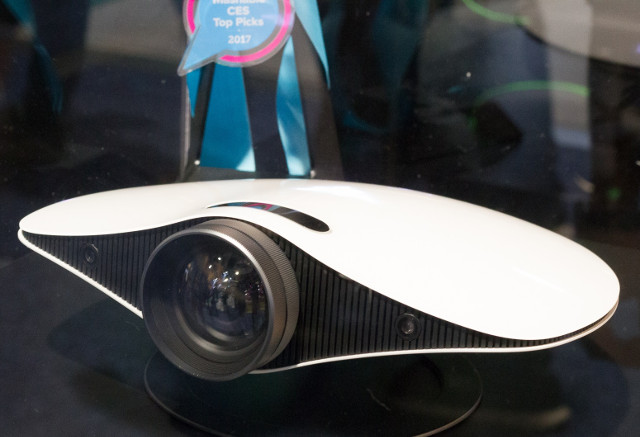Razer was at CES to unveil a new concept called Project Ariana. This is not a product yet, but it is a rather novel and interesting concept.
Razer is well known for its Chroma product which looks at the content playing on the screen and outputs new RGB content to complement the main image. This stream can go to a Chroma-enable keyboard, mouse, lighting fixture or other devices. Think of this as ‘Ambilight for gamers’.
Project Ariana takes this to the next level by introducing a projector as an accessory. It is a little unclear exactly how it works, but it includes a stereo camera system that first maps the room for objects. These objects are then taken into account in how the images are mapped by the projector, which has a fisheye lens to create a very wide angle image. We presume if a lamp is in the way, images that would normally impinge on it are removed. That’s kind of like projection mapping in reverse.

We did not see this at CES, but based on videos and images we saw on the web, it looks as though the idea is that you continue to use a TV or monitor as your main gaming screen, with the projector filling up the room with an extension of these images to create a more immersive experience. The depth sensors are used to remove the part of the projected image that overlays the TV or monitor (see before and after images below).
The developer has the opportunity to do whatever they want with this additional canvas outside of the main gaming screen. It can be an extension of the gaming environment or just lighting or related graphics. It is an open platform.
To help create an ecosystem for what to do with this additional canvas, Razer also announced a number of partnerships. For example, Chroma is already compatible with the Philips hue lighting systems, so that lighting can part of the ancillary game play canvas. Wicked Laser is a compatible accessory that shoots lasers at the walls related to the game play. Nanoleaf has illuminated tiles on the wall that can be coordinated. Other manufacturers interested in developing for the platform include Antec, Lenovo, Lian Li, and NZXT.
The idea is very similar to the concept proposed by Microsoft in 2013 called IllumiRoom, where game play was extended outside of the TV or monitor into the room. (we reported on the project a number of times in Display Monitor in 2013/2014)
Razer plans to develop Project Ariana into a consumer-ready model by the end of this year. The company is welcoming feedback on Razer’s Facebook and Twitter pages for those interested in shaping the future of the projector prototype. – CC

